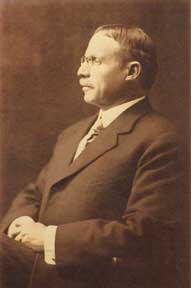Esenwein & Johnson - Table of Contents
Bios - Esenwein & Johnson
After Green & Wicks, Esenwein & Johnson enjoyed the most active architectural practice in Buffalo, New York, at the turn of the twentieth century. The firm had offices at 775-793 Ellicott Square.
The firm was one of the eight official architects for the Pan-American Exposition. Its most notorious structure was also the shortest lived. The Temple of Music was the site of President McKinley's ill-fated meeting with assassin Leon Czolgosz in September 1901.
In the erection of the fireproof store at Main and Mohawk streets in Buffalo, in one hundred and twenty days, the firm made a world's record for a building of this size and construction.One of their notable designs -- the first Statler Hotel (Hotel Buffalo) was demolished.

August Esenwein (1856-1926)
His family, which belonged to the knightly order, lived for more than 500 years on its ancestral estates called Esenwein-Virnsberg, in the Kingdom of Wuertemburg, South Germany. Esenwein's father came to America in 1861, stayed ten years, but then returned to Germany with his wife.
Esenwein was born in Esenwein-Virnsberg. His rudimentary education was obtained at private schools, and later he entered the Gymnasium at Stuttgart, and was there prepared for the University at Stuttgart. In 1874 he became a student in the Stuttgart Polytechnic University, where he remained for five years, also serving a year in the German army. While at Stuttgart he pursued courses in architecture and engineering, graduating in 1879. He then went to Paris, the world center for architectural theory and education at that time, where for two years he worked in an architect's studio as a draughtsman.
He emigrated to Buffalo in 1880 where he first found employment as a draughtsman. Later he spent two years in the engineering office of the Delaware & Western Railroad. While there he won the first prize for a design for the first Buffalo Music Hall in 1882; which was built under his supervision. (The Music Hall burned down in 1885, taking St. Louis Church with it; the new Music Hall was designed by Richard Waite. It later became the Teck Theater.)
On leaving he employ of the railroad, he began the practice of his profession for himself.
He married Katherine Haberstro, daughter of Philip L. Haberstro and Barbara Scheu of Buffalo. Their one child, August Carl, was born in 1906.
In 1897, Esenwein formed a partnership with James Addison Johnson - an association that would continue until Mr. Esenwein's death in 1926.
Esenwein was a member of the Pan-American Board of Architects. The firm designed the Temple of Music (where President McKinley was assassinated), the Administration Building, Alt Nurnberg, and the brick art gallery.
After a yearlong illness, he died at the age of 70 in his home at 167 Oxford St. (which he designed and which was a show place in Buffalo for many years). He was buried in Forest Lawn.After Esenwein died, Frank B. Kelly joined the firm as a partner, and the name of the firm, Esenwein & Johnson, continued. After Johnson died, Kelly finally dissolved the firm in 1942. Some of the firm's records were given to the Buffalo & Erie County Historical Society.
Obituary photoJames A. Johnson (1865-1939)
Born near Syracuse, N.Y. and educated in the U.S.Johnson worked for Edward Kent, and later Silsbee & Marling. Johnson partnered with James Marling after Marling's previous partner, Herbert Burdett died.
He worked for the Richard Morris Hunt firm, and in 1890 he joined McKim, Mead and White in New York as an assistant.
Johnson came to Buffalo in 1892 and, as a partner with James Marling, designed the Alexander Main Curtiss House (1895), 780 West Ferry Street in Buffalo (now the Ronald McDonald House) two years before he became a partner of August Esenwein." 70 Oakland ... Designed by by Boughton & Johnson, it was commissioned in late 1896 and completed the following year. William H. Boughton (whose first independent commission was at 103) cited this house as one of three examples of his design ability when he applied to join the American Institute of Architects (AIA) in 1899. James A. Johnson, Boughton's partner left Boughton & Johnson to form the prominent firm of Esenwein & Johnson not long after this house was completed." - Martin Wachadlo, Oakland Place: Gracious Living in Buffalo: 70 Oakland
In 1897, at age of 32, he organized Esenwein & Johnson. He made ornament his specialty. The motifs featuring electric motors and generators that decorate the Niagara Mohawk Building -- curious precursors of Art Deco ornamentation -- were of his invention. He, along with William W. Kent of New York. (the brother of Buffalo architect Edward A. Kent), designed the inlaid marble floor of the Ellicott Square Building in 1929 where the firm had its offices.After the death of Esenwein in 1926, Johnson in retirement became advisory architect to the restoration of Old Fort Niagara.
He died in Buffalo General Hospital at the age of 73; funeral services were held in his home at 731 W. Delavan. He was buried in Oswego.
- "Memorial and Family History of Erie County" New York-Buffalo: The Genealogical Publishing Vol., 1906-8
- Martin Wachadlo, consultant